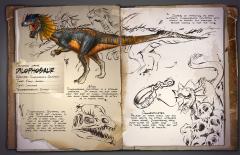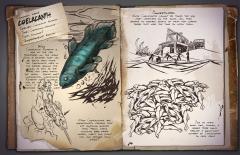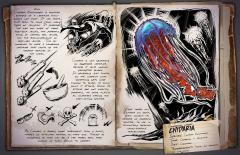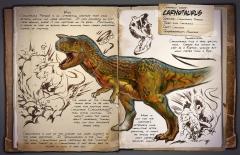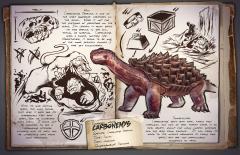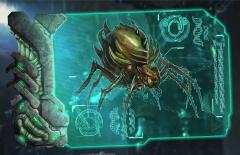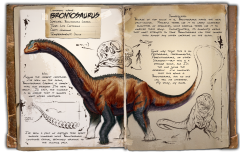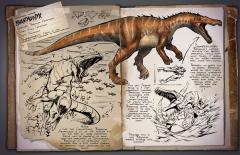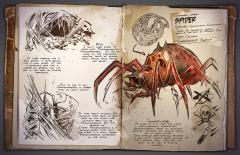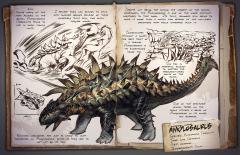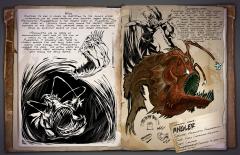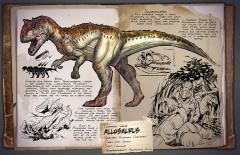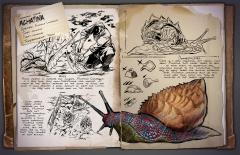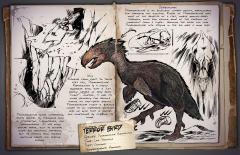-
Posts
15,571 -
Joined
-
Last visited
-
Days Won
93
Content Type
Profiles
Forums
Calendar
Gallery
ARK News
Sponsored Mods
ARK Mobile News
Everything posted by Jatheish
-
From the album: Dossiers
Common Name: Diplocaulus Species: Diplocaulus Natatorinutrix Time: Permian Diet: Piscivore Temperament: Skittish Wild: Presiding almost solely within island's swamps, Diplocaulus Natatorinutrix is a small amphibian that primarily eats minor fish. It rounds out what I consider the middle-bottom of the ecosystem, feeding on the tinier non-insect creatures of the island while itself being a common snack for the larger carnivores. Because so many creatures prey on it, Diplocaulus has become very skittish and often flees at the first sign of trouble. It uses its amphibious nature to escape into whichever environment its predator isn't native to. Diplocaulus unique capability to retain vast quantities of oxygen allows to effectively remain submerged for hours at a time, usually outlasting even other amphibious creatures that might otherwise prey upon it. Domesticated: There are only a few uses for tamed Diplocaulus. It is primarily used for the (rather disgusting) practice of employing Diplocaulus as an oxygen bag. Diplocaulus stores air in the bladders of its head, and divers can suck from these bladders to take deep breaths while submerged, supporting long-term underwater exploration without the use of external gear.-
- diplocaulus
- water
-
(and 7 more)
Tagged with:
-
From the album: Dossiers
Common Name: Dimorphodon Species: Dimorphodon equesica Time: Early Jurassic Diet: Carnivore Temperament: Reactive Wild: Dimorphodon Equesica is another of the island's Jekyll-and-Hyde creatures. It is normally passive, sometimes even friendly. When provoked, it becomes very aggressive, even against larger creatures it has no business fighting... often to its own fatal end. Dimorphodon can make short work of smaller opponents, however, due to its large (but lightweight) skull and teeth. Barely a meter tall, Dimorphodon should be low on the food chain, but its incredible speed and surprisingly strong bite makes it fairly dangerous, especially en masse as they tend to attack in groups. A flock of angry or hungry Dimorphodon can take down prey several times their size, so survivors should take care not to hunt near where a flock is gathered. Domesticated: Dimorphodon is one of the creatures on the island that is easily domesticated for companionship. But its use in combat is also quite clear: it will hunt in large groups to seek out enemy dino riders directly, harassing them to no end—regardless of the might of the mount upon they may be astride!-
- dimorphodon
- dimo
- (and 8 more)
-
From the album: Dossiers
Common Name: Dimetrodon Species: Dimetrodon calorector Time: Early Permian Diet: Carnivore Temperament: Reactive Wild: Dimetrodon Calorector is a much calmer predator than most on the island. Because it lives off smaller prey than humans, it generally ignores anything much larger than a Coelacanth. Dimetrodon is one of the few carnivores on the island that could be classified as reasonably friendly in the wild. The sail on Dimetrodon's back is a fascinating thing. It can be angled to provide shade from the sun, and allows Dimetrodon to disperse heat more quickly. The inner workings of the sail can also restrict blood flow in the creature to hold in excessive heat. Together, these two traits allow Dimetrodon to comfortably survive in any climate, though they are most commonly found in the swamplands which are rich in prey. Domesticated: If Dimetrodon was a bit larger, or didn't have that massive sail, it would make a decent mount. However, its main use to survivors is to utilize the sail's insulating capabilities. Just being near a Dimetrodon gives excellent protection from the heat and the cold, which has saved my life through more than one ice blizzard in the frozen mountains!-
- dimetrodon
- tameable
- (and 7 more)
-
From the album: Dossiers
Common Name: Dilophosaur Species: Dilophosaurus sputatrix Time: Early Jurassic Diet: Carnivore Temperament: Skittish Wild: Dilophosaurus sputatrix is a strange creature. It stands at just over half the size of known Dilophosaurs, and runs from aggressors as often as it fights them. Dilophosaurus sputatrix has a few traits not common in the Dilophosaurus genus. It has a very shrill call, and a decorative ridge of skin on its neck. I believe these are used to attract mates, as well as intimidate prey and would-be predators. Instead of attacking its prey outright, Dilophosaurus sputatrix spits venom to weaken and paralyze it before moving in for the kill. Domesticated: Because of their shrill cry and their ability to attack intruders from range, Dilophosaurus seem most suited as "guard dogs". Due to their small size, they are not suitable as mounts.-
- dilophosaur
- dilo
-
(and 8 more)
Tagged with:
-
From the album: Dossiers
Common Name: Compy Species: Compognathus curiosicarius Time: Late Jurassic Period Diet: Carnivore Temperament: Curious Wild: One of the smallest predators on the island, Compognathus curiosicarius can be seen as a pet, a pest or a threat. While alone, Compsognathus is not dangerous or aggressive. In larger packs, however, it remembers its carnivorous nature. After a group of Compsognathus grows to a certain size, their pack mentality always seems to embolden them to "attack". For some reason Compsognathus is not naturally afraid of humans. Rather it seems to be quite curious of humans and their instruments of survival. They tend to be drawn toward humans out of this curiosity, and then call their pack mates to help explore their discovery. This usually leads to the aforementioned pack aggression. Domesticated: Compsognathus's can be tamed quite easily, so some tribes keep them for little more than friendly companionship. However they gain increasing significant attack power and speed when close proximity to other Compsognathus, as their pack aggression takes over their behavior. Additionally their distress call carries quite far, rapidly alerting the tribe and its pets to danger more efficiently, and increasing the likelihood of forming a so called 'Compy Gang'.-
- compsognathus
- compy
- (and 7 more)
-
From the album: Dossiers
Common Name: Coelacanth Species: Coelacanth nutritia Time: Cretaceous-Holocene Diet: Omnivore Temperament: Reactive Wild: Coelacanth nutritia is one of the few creatures on the island with a relative that can be found back home. The Coelacanth lives in the waters around the island, as well as the rivers and lakes within the island. Unlike most Coelacanth, Coelacanth nutritia meat contains less oil and urea. In fact, it is one of the healthier sources of meat on the island. Most Coelacanths are opportunistic feeders that eat anything smaller that itself, likely including baby water snakes, insect and plant life, and perhaps each other? Domesticated: While Coelacanths cannot be tamed the way most creatures on the island can, they provide a possible source of meat for coastal tribes that have the time to catch them.-
- coelacanth
- coel
-
(and 4 more)
Tagged with:
-
From the album: Dossiers
Common Name: Cnidaria Species: Cnidaria omnimorph Time: Cambrian - Holocene Diet: Carnivore Temperament: Passive, but aggressive at close range Wild: Cnidaria omnimorph is another example of a creature which should not exist. It has traits that seem to come from many types of jellyfish. It possesses the size and shape of large egg-yolk jellies, the powerful sting of certain box jellies, and the bioluminescence of deep-sea jellies. This all combines to make a dangerous creature that lights up the deepest reaches of the ocean. Cnidaria is not generally an aggressive creature, because it lacks normal perceptive senses. it generally just floats on the current until something gets close enough to sense, at which point it attacks. While its attacks are not directly powerful, its sting injects an incredibly strong and fast-acting sedative. Most tribes kill Cnidaria on sight, then collect its reserve of powerful sedative, to use in technically advanced long-distance tranquilizers. Domesticated: As Cnidaria is barely more intelligent than a plant, there's no effective method to tame one. though dangerous as they can be, a few tribes even keep schools of them around to harvest.-
- cnidaria
- not tameable
- (and 8 more)
-
From the album: Dossiers
Common Name: Giant Beaver Species: Castoroides feliconcisor Time: Late Pliocene & Late Plestocene Diet: Herbivore Temperament: Friendly Wild: Castoroides is a large, mammalian herbivore that tends to live near water. Unlike other larger beaver species this one retains the chisel-shaped teeth of modern beavers. As is typical for beavers, they build dams as habitats, but the larger creatures on the island have a tendency to trample them. As a result, finding unsullied dams in the wild is quite rare. Castoroides itself doesn't seem to realize how dangerous the island is. I don't know if it's simply too dumb to notice the dangers, or if it just doesn't care...but Castoroides happily goes about its day playing in the water and gnawing on wood. Domesticated: The value of a tamed Castoroides is obvious from its physiology. The creature naturally gathers wood extremely efficiently, far more than most species on the island. It's not the strongest creature, so it can only carry limited amounts, but it is a natural lumberjack!-
- castoroides
- giant beaver
- (and 7 more)
-
From the album: Dossiers
Common Name: Carnotaurus Species: Carnotaurus pressor Time: Late Cretaceous Diet: Carnivore Temperament: Aggressive Wild: Carnotaurus pressor is an interesting creature that falls between medium and large predator. It lives primarily on flat clear ground, where it can capitalize on its speed. Additionally, it seems to have no qualms about running from larger predators instead of fighting. The horns of the Carnotaurus seem to be used more for fighting rival Carnotauri (Carnotauruses?) than actual hunting. This doesn't mean the horns aren't dangerous, though; they can still eviscerate larger prey. Carnotaurus is one of the smaller and more compact of the large predators. If Tyrannosaurus is the "Lion" of the island, Carnotaurus would certainly be the "cheetah". The real threat of a Carnotaurus is not being able to escape it once it sees you. Were it not for the creature's extremely long down-time after sprinting, it might be among the most capably balanced mounts. Domesticated: Carnotaurus fills a very specific role. Larger and almost as fast as a Raptor, smaller but much faster than a Tyrannosaurus. -
From the album: Dossiers
Common Name: Carbonemys Species: Carbonemys obibimus Time: Danian Diet: Herbivore Temperament: Defensive Wild: Carbonemys obibimus is one of the least aggressive creatures on the island. Were it not for the plethora of predators on the island, I'm certain it would spend its days basking in the sun, eating, or sleeping. Carbonemys leads a simple, solitary life. It seems to be one of the most peaceful animals I have yet encountered. With its slow walking speed, the only things that keep it safe are its surprisingly fast swim speed, and its incredibly thick shell. I would not be surprised to see a Carbonemys withdraw entirely into its shell and be completely safe from most predators. Domesticated: Carbonemys ' swift swim rate, fairly high strength, and lack of real threat makes it an ideal aquatic mount for many coastal survivors who shy away from violence. It can carry its rider to the ocean's resources at a fairly high speed, and are not particularly dangerous to tame.-
- carbonemys
- turtle
- (and 6 more)
-
From the album: Dossiers
-
- broodmother
- boss
-
(and 1 more)
Tagged with:
-
From the album: Dossiers
Common Name: Brontosaurus Species: Brontosaurus lazarus Time: Late Cretaceous Diet: Herbivore Temperament: Docile Wild: Among the largest creatures I've seen on the island, Brontosaurus lazarus is larger than any sauropod I've read about. In fact, the dinosaur is so massive that it ignores most other creatures. I've seen a pack of Raptors tear apart smaller Dinosaurs while Brontosaurus continues eating, seemingly oblivious to the hunting pack. The Brontosaurus is extremely protective of its eggs and will attack if provoked. However, some may think this is an Apatosaurus, Dreadnoughtus, Argentinosaurus, or other sauropod - but this is a strange island and I'm the one doing the research. I'm convinced that this genus is Brontosaurus and no one can tell me otherwise. My study, my rules. Domesticated: Because of how docile it is, Brontosaurus makes the ideal pack-animal. Peaceful tribes use it to carry incredible quantities of resources, while warring tribes use it to mobilize their army. Unfortunately, its enormity means that most attempts to tame Brontosaurs can take longer than almost any other creature on the island. -
From the album: Dossiers
Common Name: Beelzebufo Species: Beelzebufo palucocus Time: Late Cretaceous Diet: Carnivore Temperament: Languorous Wild: Beelzebufo palucocus is the largest frog I've ever seen. Almost impossibly large, it can actually fit a full grown human adult on its back, though just barely. This is a dangerous prospect, though, as secretions from Beelzebufo's skin and saliva have a narcotic effect on most creatures. Not surprisingly, Beelzebufo is adept at killing insects. In fact, it kills most insects near-instantly, and quickly digests them. It even combines the narcotic chemicals in its mouth with the insects' chitin to create a sticky substance, allowing it to quickly grab prey from afar, and yielding a form of cementing paste. Domesticated: Tamed Beelzebufo make for strange mounts. Strange mounts for strange people. Many tribes don't believe there's any reason to ride them. But some like the ability to take large vertical hops up huge walls and cliffs. Regardless of how it is ridden, Beelzebufo is also employed for its ability to quickly cull insects, and convert them into always-useful cementing paste.-
- beelzebufo
- frog
- (and 9 more)
-
From the album: Dossiers
Common Name: Baryonyx Species: Baryonyx Aquafulgur Time: Early Cretatceous Diet: Piscivore Temperament: Passive to land creatures, but aggressive to water-dwellers Wild: Like the Carnotaurus, Baryonyx Aquafulgur is one of the smaller end of the tier of large predators. While not as powerful as some deep sea predators or Spinosaurus, Baryonyx is an extremely fast swimmer who is still nimble enough to threaten most creatures on the island. And yet despite being a fast, dangerous dinosaur, Baryonyx almost exclusively eats fish & other water-dwellers. The highly specific metabolism of Baryonyx seems to allow it to heal wounds almost preternaturally fast after feeding on nutritious fish meat. Perhaps this is why Baryonyx rarely attacks land animals? Domesticated: Baryonyx's natural affinity for aquatic predation means that once tamed, it learns to kill ocean-dwellers more efficiently. Between its speed and its power, Baryonyx makes an ideal choice for anyone interested in frequently moving between water and land travel with ease, and valuing speend and agility over raw strength. -
From the album: Dossiers
Common Name: Arthropluera Species: Arthropluera Felsanguis Time: Early Permian Diet: Carrion-Feeder Temperament: Aggressive Wild: The fact that this creature exists is enough to give me nightmares. Like the island's other Arthropods, Arthropluera Felsanguis has become much larger than I might have believed possible. It's a very aggressive hunter, but prefers to eat meat after it has rotted for some time, and will voraciously seek out such delicacies. Arthropleura's blood has a very low pH, to the point that it can dissolve many materials. This acidic blood splashes back on anything that directly attacks it, weakening the durability of weapons and hurting attackers. Many creatures thusly refuse to prey on Arthropleura, fearing this unique defense. If that wasn't enough, Arthropleura also keeps a small reservoir of blood ready to spit at its prey. Domesticated: Like most of the arthropods on the island, Arthropleura is simple minded and relatively easy to tame. It is an almost entirely military mount, useful mostly for attacking at a distance. Thanks to its unique defenses, whether hunting or warring, Arthropleura is generally safe from all but the largest of creatures.- 2 comments
-
- arthropluera
- invertebrate
- (and 5 more)
-
From the album: Dossiers
Common Name: Argentavis Species: Argentavis atrocollum Time: Late Miocene Diet: Carrion-Feeder Temperament: Short-Tempered Wild: Lording over the skies across the island, Argentavis atrocollum has few aerial rivals. It is a small consolation for the island's other avian Creatures, then, that Argentavis seems to have little interest in anything alive. Although they are not interested in many animals, Argentavis will attack any human within sight making them an aerial threat to many humans with basic equipment. Quite apart from what I would have guessed, Argentavis does not have the stooped neck typical of modern buzzards and vultures. It is unknown if it adapted this stronger neck to deal with predators on the island, or if its lineage comes from before the stooped neck became common in carrion-eating birds. Domesticated: Argentavis is actually slower than the far more common Pteranodon, but it has significantly more Stamina, and can sustain flight for approximately three times as long. This makes them the best Creatures on the island for traveling or hauling cargo over long distances.-
- argentavis
- argent
- (and 8 more)
-
From the album: Dossiers
Common Name: Spider Species: Araneomorphus amalgotantibus Time: No Equivalent, traits begin as far as Mesozoic Era Diet: Carnivore Temperament: Aggressive Wild: I don't know where to start with Araneomorphus amalgotantibus. It has so many of the nightmare inducing traits of spiders from among many family and genus. It fires webbing like a bola spider, it spits venom like a lynx spider. It has a poisonous bite like a myriad of spiders, and can see in the dark by sensing vibrations. And to top it off, Araneomorphus is larger than an adult human! If that wasn't enough, I'm convinced that some of the caves on the island have actually been dug by Araneomorphus, but this worries me. Either Araneomorphus is a colony-spider (like ants), or there is a much larger Araneomorphus somewhere on the island. Domesticated: As long as it is kept far from arachnophobics, domesticated Araneomorphus makes an excellent guardian creature for anyone wanting to avoid killing. Their strange web-spraying behavior is also quite helpful while hunting fast, fleeing prey. They are too small to be used as mounts, however...- 1 comment
-
- araneomorphus
- araneo
- (and 10 more)
-
From the album: Dossiers
Common Name: Ankylosaurus Species: Ankylosaurus crassacutis Time: Late Cretaceous Diet: Herbivore Temperament: Docile Wild: Unlike many of the herd animals on the island, Ankylosaurus crassacutis tends to live in small family units. I believe they can afford to stick with smaller groups because of their incredibly thick skin for which they're named. Despite not being among the largest of the islands herbivores, the Ankylosaurus is one of the more difficult Creatures to take down. Its thick, armored skin seems to make it more than a match for several of the mid-sized predators that would otherwise hunt it. Reckless carnivores are just as likely to hurt themselves on Ankylosaurus' spikes as they are to get hit by its tail. Domesticated: Without a doubt, the best trait of a trained Ankylosaurus is its enormously dense tail. This tail is powerful enough to shatter the resource-laden rocks of the island. One of the wealthier human tribes on the island utilizes a squad of Ankylosaurus in its mines and quarries.-
- ankylosaurus
- ankylo
- (and 11 more)
-
From the album: Dossiers
Common Name: Pegomastax Species: Melanocetus Anglerprescum Time: Early Cretaceous-Holocene Diet: Carnivore Temperament: Aggressive to small fry, otherwise skittish! Wild: Whether it’s size is caused by adaptation to the island’s other inhabitants, or by cross-breeding with another larger species, Melanocetus Anglerprescum is the largest form of Anglerfish I’ve ever heard of. Typically found only among the deepest, darkest expanses of the ocean, this creature preys on smaller fish while being an excellent source of food for larger predators. Melanocetus has an array of bioluminescent light pods at the end of stalks on it’s head. Like typical Anglerfish, it primarily uses these to attract smaller fish and trick them into coming close enough for Melanocetus to consume it’s prey. This often makes wild Melanocetus itself relatively easy to spot among the briny depths. Domesticated: Exploring the depths of the ocean can be difficult. The cold, the lack of air, and the shocking absence of light combine to make travel very dangerous. A tamed Anglerfish can use the natural light at the end of it’s stalks to illuminate the depths, making exploration not only safer, but more lucrative. Furthermore, these luminescent nodules can be harvested to create long-lasting organic light emplacements for surface dwellings. -
From the album: Dossiers
Common name: Allosaurus Species: Allosaurus Therotribus Time: Late Jurassic Diet: Carnivore Temperament: Aggressively Social Wild: Smaller but faster than tyrannosaurus, larger but slower than Carnotaurus, Allosaurus Therotribus is the island's resident pack-hunting theropod. While most aggressive theropods are relatively solitary creatures, Allosaurus lives in groups of 3-4. One Allosaurus is the alpha, while the others are its mates or a beta male. Like humans find value in forming a tribe, the Allosaurus has evolved to hunt in packs. Its saw-shaped teeth leave its prey bleeding and maimed, making escape difficult. Once an Allosaurus slows a creature with its cutting bite, the rest of its pack quickly close in for the kill. Domesticated: Not everyone thinks a tamed Allosaurus is ideal. Those who value speed generally tame Carnotaurus, while those who value raw stopping power tame Tyrannosaurus. However, Riders of Allosaurus tend to value the utility of its Alpha pack status, which along with its bleed-inducing attacks and relative mobility, can effectively turn the tide of a combined arms battle.- 1 comment
-
- allosaurus
- rideable
- (and 8 more)
-
From the album: Dossiers
Common Name: Achatina Species: Achatina Limusegnis Time: Holocene Diet: Herbivore Temperament: Passive Wild: Found mostly in marshes and jungles, Achatina Lumusegnis is a very slow, very non-threatening land mollusk. It might be the safest creature on the island to hunt, and while it only provides a small amount of meat and Chitin, An easy meal is always good on the island. Unlike nearly every other creature on the island, Achatina does not defecate normally. Instead, it secretes a thick, sticky substance. Achatina leaves trails of this slime, but the trails are so thin that they crumble to dust quickly. Domesticated: There is a very diguesting, but useful, fact about achatina that causes tribes to seek to tame them: its secretions are chemically similar to the 'cementing paste' used by many tribes for building materials. Tamed Achatina naturally build up this slime over time, which can then be collected at the tribe’s convenience.- 2 comments
-
From the album: Dossiers
Common Name: Terror Bird Species: Phorusrhacidae Rapidesultor Time: Late Paleocene Diet: Carnivore Temperament: Aggressive Wild: Ranging from eight to twelve feet tall, Phorusrhacidae Rapidesultor is a highly aggressive avian that is just barely capable of very brief "flight" . Instead, it uses its wings primarily for balance during its high-speed sprints. Phorusrhacidae flight is actually closer so an impressive sustained leap or glide that is assisted and lengthened by flapping its wings. Phorusrhacidae shows interesting traits related to theropods such as Utahraptor, Carnotaurus and Tyrannosaurus. It has many similar traits such as general shape and predation patterns, but its attacks tend towards lightening dashes and leaping slashes. Domesticated: Phorusrhacidae is an excellent combat mount, particularly for harassing and scouting. Riders of Phorusrhacidae gain most of the benefits of a fast, mobile ground-based theropod, while also gaining some of the freedom of movement from a flyer... Assuming the rider can coax Phorusrhacidae into staying in the air over a long leap. -
From the album: Dossiers
Common Name: Dung Beetle Species: Scarabidae Gigas Time: Holocene Diet: Coprophagic Temperament: Passive Wild: What magic created the Scarabidae Gigas, I cannot say. What I can say is that this creature is a perfect symbiont for advanced human tribes. Coprophagic, it eats mostly useless waste (feces). It metabolizes this waste into a more refined waste product, along with an oily byproduct. The oily byproduct is chemically the same as the oil found in the oceans around the island. Somehow, Scarabidae converts feces into oil. If that wasn't reason enough to worship the Scarabidae, the refined waste product is almost identical to fertilizer from a compost bin. Domesticated: Scarabidae makes me think humans have been on the island for a long time. Why else would a creature evolve to be such a perfect pet? Most tribes jealously protect their scarabidae, whom are handily tamed with the skilled use of some well-handled feces. These wondrous little organic biofactories are truly a sustainable, green, eco-friendly source of resources for living off the land. Oil becomes gas, which is generator fuel. Fertilizer means crops, which is human fuel. The scarabidae can power all aspects of island life!-
- dung beetle
- bug
-
(and 8 more)
Tagged with:
-
From the album: Events




